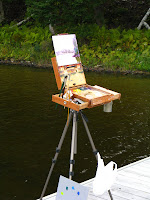It seems so simple. Put the right pigment in the right place. Getting it "right" is another matter.
Given that you are painting from life or on site, one of the most valuable technical skills is simplification. On site the complexity of nature can be overwhelming. The most direct way to simplify is to squint at the subject before you. Thats right, partially close your eyes until the majority of the detail disappears leaving an image of a few simple coherent shapes. Another benefit is that the key edges will also appear. Zorn and Sorolla were masters at this method of simplification. Schmid and Leffel are masters of this technique. With practice you can also be a master. Beware of squinting crows feet around the eyes.
Scotsdale Image in the AM
Here is a simple image from this morning for example. Tangle everywhere. What to paint? What shapes, what values, what edges? Remember this is a photo so the sky is near colourless. Here is what it might look like squinting - don't adjust your set.
Sqinting at the Subject
Now you can see the basic few (4) shapes. You also get to see the relative values and the few hard edges (your eye is drawn to these).
If you squint, the colour is distorted and greyed so it might look more like this.....
But Not to be Used for Colour Determination
From here you can compose a thumbnail composition and formulate your concept for the painting. Just before this photo the background hill was much darker, but not as dark as the fence posts. In any event the fence line is a nice lead in. Has to be subordinated or it will be the subject. My concept included showing stacked elements dark against light and changing to light against dark. This device adds depth to the image














2.jpg)








